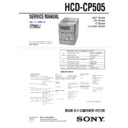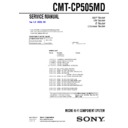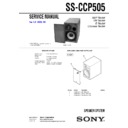Read Sony CMT-CP505MD / HCD-CP505 Service Manual online
HCD-CP505
AEP Model
UK Model
E Model
Chinese Model
MICRO HI-FI COMPONENT SYSTEM
— Continued on next page —
SPECIFICATIONS
HCD-CP505 is the Amplifier, CD player, MD
deck, Tape player and Tuner section in
CMT-CP505MD.
deck, Tape player and Tuner section in
CMT-CP505MD.
Model Name Using Similar Mechanism
NEW
CD Mechanism Type
CDM55G-30BBD61B
Base Unit Type
BU-30BBD61B
Optical Pick-up Type
A-MAX. 3
Model Name Using Similar Mechanism
NEW
MD Mechanism Type
MDM-7S2C
Optical Pick-up Type
KMS-262E
Model Name Using Similar Mechanism
NEW
Tape Transport Mechanism Type
CMAL1Z-221A
CD
Section
MD
Section
Tape deck
Section
9-874-070-08
2009L05-1
© 2009.12
Ver. 1.7 2009.12
SERVICE MANUAL
Sony Corporation
Audio&Video Business Group
Published by Sony Techno Create Corporation
Amplifier section
European model:
DIN power output (rated): 30 + 30 W
DIN power output (rated): 30 + 30 W
(6 ohms at 1 kHz, DIN)
Continuous RMS power output (reference):
35 + 35 W
(6 ohms at 1 kHz, 10%
THD)
(6 ohms at 1 kHz, 10%
THD)
Music power output (reference):
70 + 70 W
Other models:
The following measured at 230 V AC, 60 Hz
DIN power output (rated): 25 + 25 W
The following measured at 230 V AC, 60 Hz
DIN power output (rated): 25 + 25 W
(6 ohms at 1 kHz, DIN)
Continuous RMS power output (reference):
30 + 30 W
(6 ohms at 1 kHz, 10%
THD)
(6 ohms at 1 kHz, 10%
THD)
The following measured at 220 V AC, 60 Hz
DIN power output (rated): 22 + 22 W
DIN power output (rated): 22 + 22 W
(6 ohms at 1 kHz, DIN)
Continuous RMS power output (reference):
28 + 28 W
(6 ohms at 1 kHz, 10%
THD)
(6 ohms at 1 kHz, 10%
THD)
Inputs
ANALOG IN:
ANALOG IN:
Sensitivity 250 mV,
(phono jacks)
impedance 47 kilohms
DIGITAL OPTICAL IN (supported sampling
frequencies: 32 kHz, 44.1 kHz and 48 kHz)
frequencies: 32 kHz, 44.1 kHz and 48 kHz)
Outputs
PHONES:
PHONES:
Accepts headphones with
an impedance of 8 ohms
or more
an impedance of 8 ohms
or more
SPEAKER:
accepts impedance of 6 to
16 ohms.
16 ohms.
CD player section
System
Compact disc and digital
audio system
audio system
Laser
Semiconductor laser
(
(
λ=780 nm)
Emission duration:
continuous
continuous
Frequency response
2 Hz – 20 kHz
MD deck section
System
Minidisc digital audio
system
system
Laser
Semiconductor laser
(
(
λ=780 nm)
Emission duration:
continuous
continuous
Sampling frequency
44.1 kHz
Frequency response
5 Hz – 20 kHz
Tape deck section
Recording system
4-track 2-channel stereo
Frequency response
50 – 13,000 Hz (
±3 dB),
using Sony TYPE I
cassettes
cassettes
2
HCD-CP505
Tuner section
FM stereo, FM/AM superheterodyne tuner
FM tuner section
Tuning range
FM tuner section
Tuning range
87.5 - 108.0 MHz
(50-kHz step)
(50-kHz step)
Antenna
FM wire antenna
Antenna terminals
75 ohms unbalanced
Intermediate frequency
10.7 MHz
AM tuner section
Tuning range
European model:
Tuning range
European model:
531 - 1,602 kHz
(with the tuning interval
set at 9 kHz)
(with the tuning interval
set at 9 kHz)
Other models:
530 - 1,710 kHz
(with the tuning interval
set at 10 kHz)
531 - 1,602 kHz
(with the tuning interval
set at 9 kHz)
(with the tuning interval
set at 10 kHz)
531 - 1,602 kHz
(with the tuning interval
set at 9 kHz)
Antenna
AM loop antenna, external
antenna terminal
antenna terminal
Intermediate frequency
450 kHz
General
Power requirements
European model:
European model:
230 V AC, 50/60 Hz
Other models:
110 – 120 V or
220 – 240 V AC,
50/60 Hz
Adjustable with voltage
selector
220 – 240 V AC,
50/60 Hz
Adjustable with voltage
selector
Power consumption
European model:
European model:
See the name plate
0.3 watts (at the Power
Saving mode)
0.3 watts (at the Power
Saving mode)
Other models:
See the name plate
Dimensions (w/h/d) incl. projecting parts and controls
Amplifier/Tuner/Tape/MD/CD section:
Amplifier/Tuner/Tape/MD/CD section:
Approx. 175
× 240 ×
341.5 mm
Speaker:
Approx. 152
× 240 ×
258.5 mm
Mass
Amplifier/Tuner/Tape/MD/CD section:
Amplifier/Tuner/Tape/MD/CD section:
Approx. 6.1 kg
Speakers:
Approx. 2.6 kg net per
speaker
speaker
Supplied accessories
Remote (1)
R6 (size AA) batteries (2)
AM loop antenna (1)
FM lead antenna (1)
R6 (size AA) batteries (2)
AM loop antenna (1)
FM lead antenna (1)
Optional accessories
Sony PC connection kit
(See the catalogue and
other promotional
materials for the release
date.)
The optional accessories
for this system are subject
to change without notice.
For details, consult your
nearest Sony dealer.
(See the catalogue and
other promotional
materials for the release
date.)
The optional accessories
for this system are subject
to change without notice.
For details, consult your
nearest Sony dealer.
Design and specifications are subject to change
without notice.
without notice.
This appliance is
classified as a CLASS 1
LASER product. This
label is located on the
rear exterior.
classified as a CLASS 1
LASER product. This
label is located on the
rear exterior.
Laser component in this product is capable
of emitting radiation exceeding the limit for
Class 1.
of emitting radiation exceeding the limit for
Class 1.
NOTES ON HANDLING THE OPTICAL PICK-UP
BLOCK OR BASE UNIT
BLOCK OR BASE UNIT
The laser diode in the optical pick-up block may suffer electrostatic
break-down because of the potential difference generated by the
charged electrostatic load, etc. on clothing and the human body.
During repair, pay attention to electrostatic break-down and also
use the procedure in the printed matter which is included in the
repair parts.
The flexible board is easily damaged and should be handled with
care.
break-down because of the potential difference generated by the
charged electrostatic load, etc. on clothing and the human body.
During repair, pay attention to electrostatic break-down and also
use the procedure in the printed matter which is included in the
repair parts.
The flexible board is easily damaged and should be handled with
care.
FOR CD
NOTES ON LASER DIODE EMISSION CHECK
The laser beam on this model is concentrated so as to be focused on
the disc reflective surface by the objective lens in the optical pick-
up block. Therefore, when checking the laser diode emission,
observe from more than 30 cm away from the objective lens.
the disc reflective surface by the objective lens in the optical pick-
up block. Therefore, when checking the laser diode emission,
observe from more than 30 cm away from the objective lens.
FOR MD
NOTES ON LASER DIODE EMISSION CHECK
Never look into the laser diode emission from right above when
checking it for adjustment. It is feared that you will lose your sight.
checking it for adjustment. It is feared that you will lose your sight.
CAUTION
Use of controls or adjustments or performance of procedures
other than those specified herein may result in hazardous radiation
exposure.
other than those specified herein may result in hazardous radiation
exposure.
Notes on chip component replacement
• Never reuse a disconnected chip component.
• Notice that the minus side of a tantalum capacitor may be
• Notice that the minus side of a tantalum capacitor may be
damaged by heat.
Unleaded solder
Boards requiring use of unleaded solder are printed with the lead-
free mark (LF) indicating the solder contains no lead.
(Caution: Some printed circuit boards may not come printed with
the lead free mark due to their particular size.)
free mark (LF) indicating the solder contains no lead.
(Caution: Some printed circuit boards may not come printed with
the lead free mark due to their particular size.)
The following caution label is located inside the apparatus.
3
HCD-CP505
1. SERVICING NOTES
····················································· 10
2. GENERAL
········································································ 12
3. DISASSEMBLY
······························································ 15
3-1. Top Panel Section ·························································· 16
3-2. Cassette Mechanism Deck ············································ 16
3-3. Front Panel, MD Mechanism Deck Block ···················· 17
3-4. SWITCH Board, JACK Board ······································ 18
3-5. Back Panel Section (Including OPTICAL Board,
3-2. Cassette Mechanism Deck ············································ 16
3-3. Front Panel, MD Mechanism Deck Block ···················· 17
3-4. SWITCH Board, JACK Board ······································ 18
3-5. Back Panel Section (Including OPTICAL Board,
OPTICAL RETAINER Board) ····································· 19
3-6. MAIN Board ································································· 19
3-7. POWER Board ······························································ 20
3-8. CONTROL Board, CD Mechanism Deck
3-7. POWER Board ······························································ 20
3-8. CONTROL Board, CD Mechanism Deck
(CDM55G-30BBD61B) ················································ 20
3-9. Cam (CDM55) ······························································ 21
3-10. Base Unit (BU-30BBD61B) ········································ 21
3-11. Optical Pick-Up (BU-30B Assy) ································· 22
3-12. MD Mechanism Deck (MDM-7S2C) ·························· 22
3-13. DIGITAL Board ·························································· 23
3-14. Holder Section ····························································· 23
3-15. BD (MD) Board ·························································· 24
3-16. Loading Motor Assembly (M103),
3-10. Base Unit (BU-30BBD61B) ········································ 21
3-11. Optical Pick-Up (BU-30B Assy) ································· 22
3-12. MD Mechanism Deck (MDM-7S2C) ·························· 22
3-13. DIGITAL Board ·························································· 23
3-14. Holder Section ····························································· 23
3-15. BD (MD) Board ·························································· 24
3-16. Loading Motor Assembly (M103),
Spindle Motor Assembly (M101),
Sled Motor Assembly (M102) ····································· 24
Sled Motor Assembly (M102) ····································· 24
3-17. Over Wright Head (HR901) ········································ 25
3-18. Mini Disc Device (KMS-262E) ·································· 25
3-18. Mini Disc Device (KMS-262E) ·································· 25
4. TEST MODE
···································································· 26
5. ELECTRICAL ADJUSTMENTS
······························· 31
6. DIAGRAMS
······································································ 44
6-1. Circuit Boards Location ················································ 45
6-2. Block Diagrams ····························································· 46
6-2. Block Diagrams ····························································· 46
MD Section ··································································· 46
CD and Main Section ···················································· 47
CD and Main Section ···················································· 47
TABLE OF CONTENTS
SAFETY-RELATED COMPONENT WARNING!!
COMPONENTS IDENTIFIED BY MARK
0
OR DOTTED LINE WITH
MARK
0
ON THE SCHEMATIC DIAGRAMS AND IN THE PARTS
LIST ARE CRITICAL TO SAFE OPERATION. REPLACE THESE
COMPONENTS WITH SONY PARTS WHOSE PART NUMBERS
APPEAR AS SHOWN IN THIS MANUAL OR IN SUPPLEMENTS
PUBLISHED BY SONY.
COMPONENTS WITH SONY PARTS WHOSE PART NUMBERS
APPEAR AS SHOWN IN THIS MANUAL OR IN SUPPLEMENTS
PUBLISHED BY SONY.
6-3. Printed Wiring Board – BD (CD) Board – ··················· 48
6-4. Schematic Diagram – BD (CD) Board – ···················· 49
6-5. Printed Wiring Board – BD (MD) Board – ················ 50
6-6. Schematic Diagram – BD (MD) Board (1/2) – ············ 51
6-7. Schematic Diagram – BD (MD) Board (2/2) – ············ 52
6-8. Printed Wiring Board – MAIN Board – ······················· 53
6-9. Schematic Diagram – MAIN Board (1/2) – ················· 54
6-10. Schematic Diagram – MAIN Board (2/2) – ··············· 55
6-11. Printed Wiring Board – DIGITAL Board – ················ 56
6-12. Schematic Diagram – DIGITAL Board – ··················· 57
6-13. Printed Wiring Board – TC Board – ··························· 58
6-14. Schematic Diagram – TC Board – ····························· 59
6-15. Printed Wiring Board – Control Section (Side A) – ··· 60
6-16. Printed Wiring Boards – Control Section (Side B) – · 61
6-17. Schematic Diagram – Control Section (1/2) – ··········· 62
6-18. Schematic Diagram – Control Section (2/2) – ··········· 63
6-19. Printed Wiring Boards – Switch Section – ················· 64
6-20. Schematic Diagram – Switch Section – ····················· 65
6-21. Printed Wiring Board – POWER Board – ·················· 66
6-22. Schematic Diagram – POWER Board – ····················· 67
6-23. Printed Wiring Board – OPTICAL Board – ··············· 68
6-24. Schematic Diagram – OPTICAL Board – ·················· 69
6-25. IC Block Diagrams ······················································ 70
6-26. IC Pin Function Description ········································ 78
6-4. Schematic Diagram – BD (CD) Board – ···················· 49
6-5. Printed Wiring Board – BD (MD) Board – ················ 50
6-6. Schematic Diagram – BD (MD) Board (1/2) – ············ 51
6-7. Schematic Diagram – BD (MD) Board (2/2) – ············ 52
6-8. Printed Wiring Board – MAIN Board – ······················· 53
6-9. Schematic Diagram – MAIN Board (1/2) – ················· 54
6-10. Schematic Diagram – MAIN Board (2/2) – ··············· 55
6-11. Printed Wiring Board – DIGITAL Board – ················ 56
6-12. Schematic Diagram – DIGITAL Board – ··················· 57
6-13. Printed Wiring Board – TC Board – ··························· 58
6-14. Schematic Diagram – TC Board – ····························· 59
6-15. Printed Wiring Board – Control Section (Side A) – ··· 60
6-16. Printed Wiring Boards – Control Section (Side B) – · 61
6-17. Schematic Diagram – Control Section (1/2) – ··········· 62
6-18. Schematic Diagram – Control Section (2/2) – ··········· 63
6-19. Printed Wiring Boards – Switch Section – ················· 64
6-20. Schematic Diagram – Switch Section – ····················· 65
6-21. Printed Wiring Board – POWER Board – ·················· 66
6-22. Schematic Diagram – POWER Board – ····················· 67
6-23. Printed Wiring Board – OPTICAL Board – ··············· 68
6-24. Schematic Diagram – OPTICAL Board – ·················· 69
6-25. IC Block Diagrams ······················································ 70
6-26. IC Pin Function Description ········································ 78
7. EXPLODED VIEWS
7-1. Overall Section ······························································ 83
7-2. Front Panel Section ······················································· 84
7-3. Back Panel Section ························································ 85
7-4. MD Mechanism Deck Section-1 (MDM-7S2C) ··········· 86
7-5. MD Mechanism Deck Section-2 (MDM-7S2C) ··········· 87
7-6. CD Mechanism Deck Section-1
7-2. Front Panel Section ······················································· 84
7-3. Back Panel Section ························································ 85
7-4. MD Mechanism Deck Section-1 (MDM-7S2C) ··········· 86
7-5. MD Mechanism Deck Section-2 (MDM-7S2C) ··········· 87
7-6. CD Mechanism Deck Section-1
(CDM55G-30BBD61B) ················································ 88
7-7. CD Mechanism Deck Section-2 (BU-30BBD61B) ······ 89
8. ELECTRICAL PARTS LIST
······································· 90
: LEAD FREE MARK
Unleaded solder has the following characteristics.
• Unleaded solder melts at a temperature about 40
• Unleaded solder melts at a temperature about 40
°C higher than
ordinary solder.
Ordinary soldering irons can be used but the iron tip has to be
applied to the solder joint for a slightly longer time.
Soldering irons using a temperature regulator should be set to
about 350
Ordinary soldering irons can be used but the iron tip has to be
applied to the solder joint for a slightly longer time.
Soldering irons using a temperature regulator should be set to
about 350
°C.
Caution: The printed pattern (copper foil) may peel away if the
heated tip is applied for too long, so be careful!
heated tip is applied for too long, so be careful!
• Strong viscosity
Unleaded solder is more viscous (sticky, less prone to flow) than
ordinary solder so use caution not to let solder bridges occur such
as on IC pins, etc.
ordinary solder so use caution not to let solder bridges occur such
as on IC pins, etc.
• Usable with ordinary solder
It is best to use only unleaded solder but unleaded solder may
also be added to ordinary solder.
also be added to ordinary solder.
4
HCD-CP505
C41/Cannot Copy
The sound source is a copy of a commercially
available music software or CD-R.
available music software or CD-R.
cThe Serial Copy Management System prevents
making a digital copy (see page 64). In addition,
you cannot copy from a CD-R.
you cannot copy from a CD-R.
C71/Check OPT-IN
No component is connected to the DIGITAL
OPTICAL IN jack, or you tried to record from the
digital component which is not connected
correctly.
OPTICAL IN jack, or you tried to record from the
digital component which is not connected
correctly.
cConnect the optional digital component correctly
to the DIGITAL OPTICAL IN jack using the
digital optical cable (not supplied) (see page 53).
digital optical cable (not supplied) (see page 53).
The power of the connected component is not
turned on.
turned on.
cCheck if the power of the connected digital
component is on. Refer to the operating
instructions supplied with the component.
instructions supplied with the component.
The digital optical cable is disconnected, or the
power of the connected component is turned off
while recording the digital audio from the
component connected to the DIGITAL OPTICAL
IN jack.
cConnect the digital optical cable, or turn on the
power of the connected component is turned off
while recording the digital audio from the
component connected to the DIGITAL OPTICAL
IN jack.
cConnect the digital optical cable, or turn on the
power of the connected component.
E0001/MEMORY NG
The component has internal problem.
cConsult your nearest Sony dealer.
E0101/LASER NG
There is a problem with the laser pickup.
cThe laser pickup may be damaged. Consult your
nearest Sony dealer.
E0201/LOADING NG
There is a problem with the loading.
cConsult your nearest Sony dealer.
Self-diagnosis display
This system has a Self-diagnosis display
function to let you know if there is a system
malfunction. The display shows a code made
up of three or five letters and a message
alternately to show you the problem. To solve
the problem refer to the following list. If any
problem persists, consult your nearest Sony
dealer.
function to let you know if there is a system
malfunction. The display shows a code made
up of three or five letters and a message
alternately to show you the problem. To solve
the problem refer to the following list. If any
problem persists, consult your nearest Sony
dealer.
C11/Protected
The MD is protected against erasure.
cRemove the MD and slide the tab to close the
cRemove the MD and slide the tab to close the
slot (see page 17).
C12/Cannot Copy
You tried to record a CD with a format that the
system does not support, such as a CD-ROM.
system does not support, such as a CD-ROM.
cRemove the disc and turn off the system once,
then turn it on again.
C13/REC Error
Recording could not be performed properly.
cMove the system to a stable place, and start
recording over from the beginning.
The MD is dirty or scratched, or the MD does not
meet the standards.
meet the standards.
cReplace the MD and start recording over from
the beginning.
C13/Read Error
The MD deck cannot read the disc information
properly.
properly.
cRemove the MD once, then insert it again.
C14/TOC Error
The MD deck cannot read the disc information
properly.
cReplace the MD.
cErase all the recorded contents of the MD using
properly.
cReplace the MD.
cErase all the recorded contents of the MD using
the All Erase Function (see page 34).



